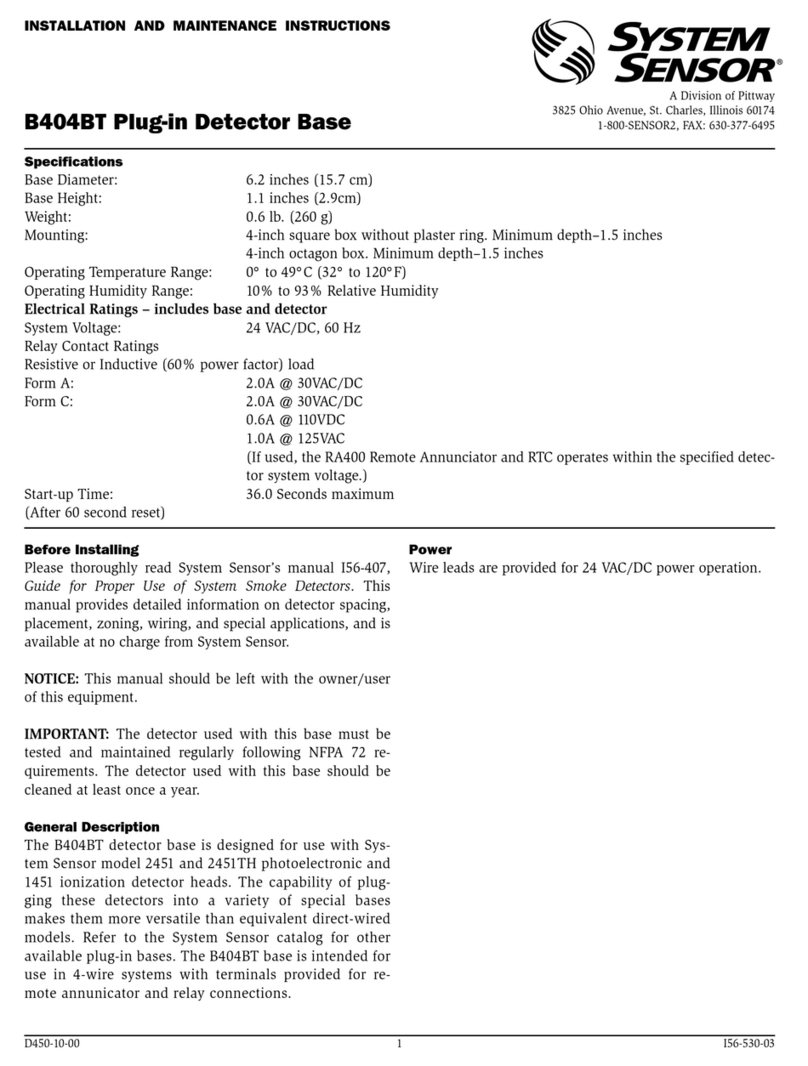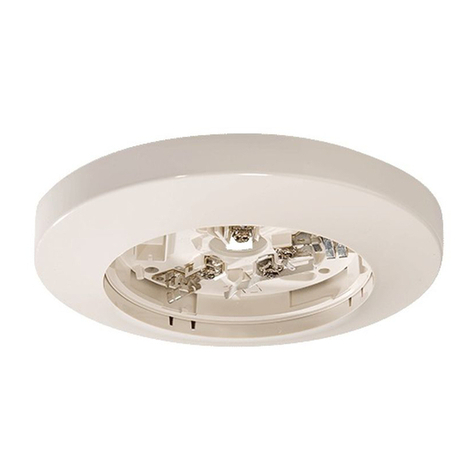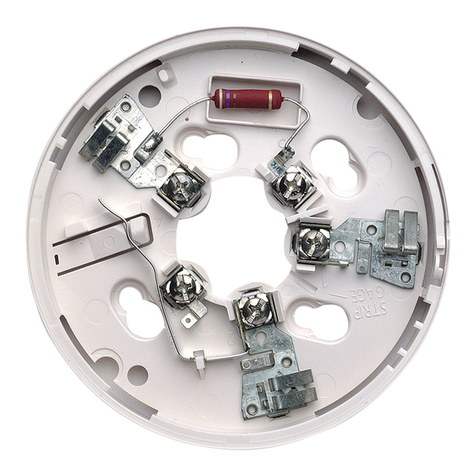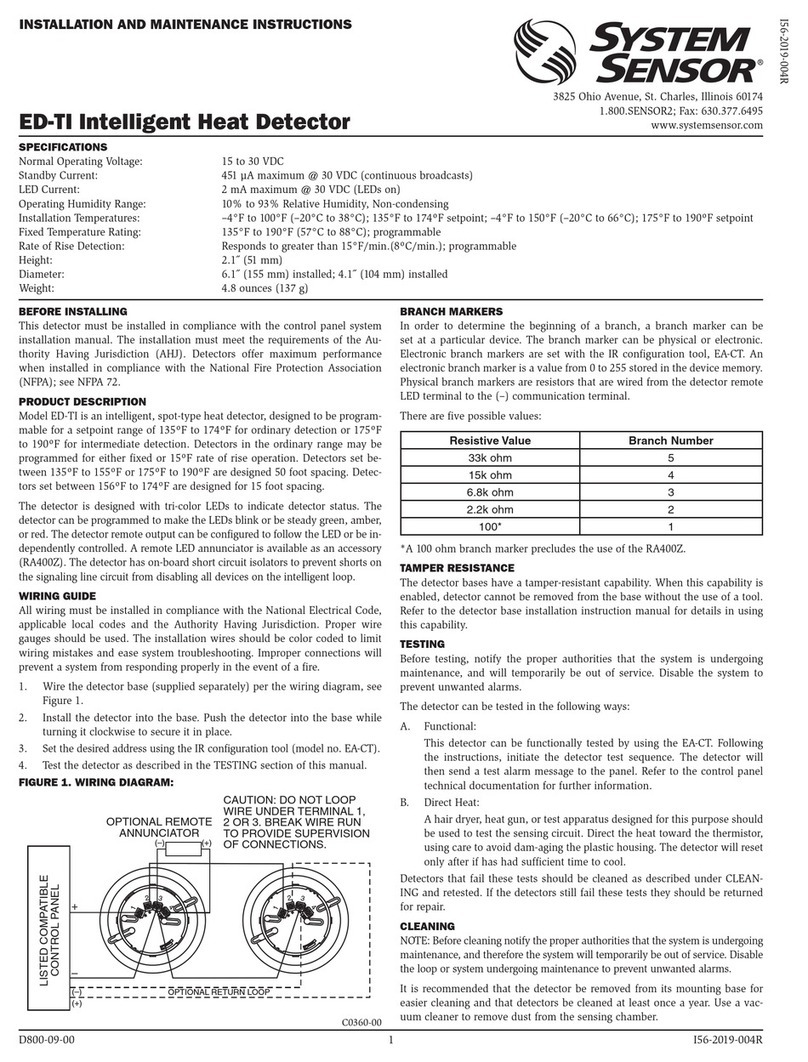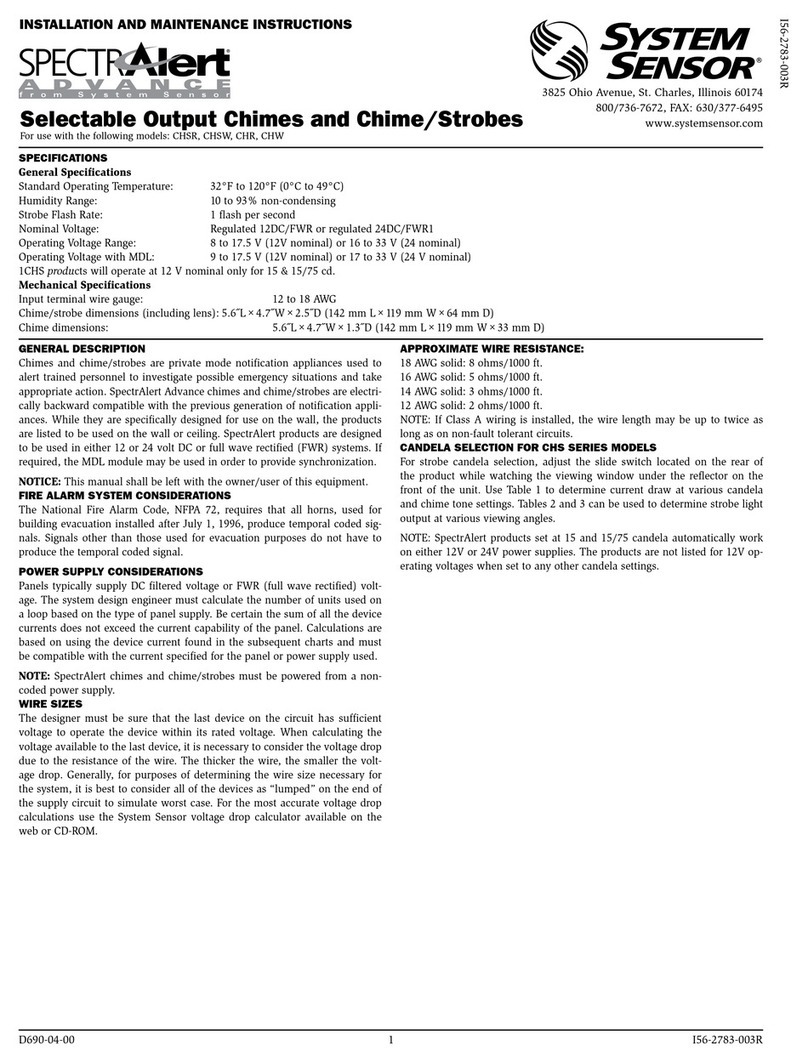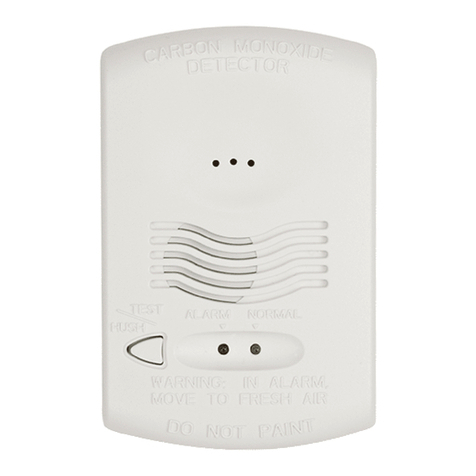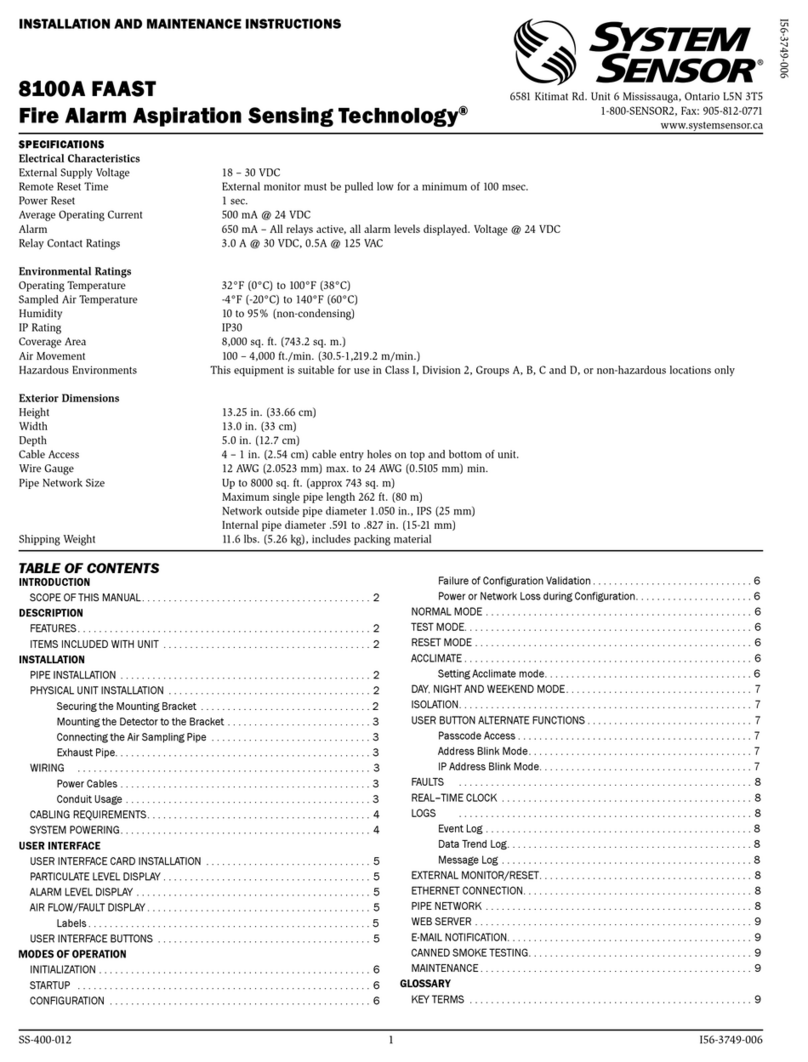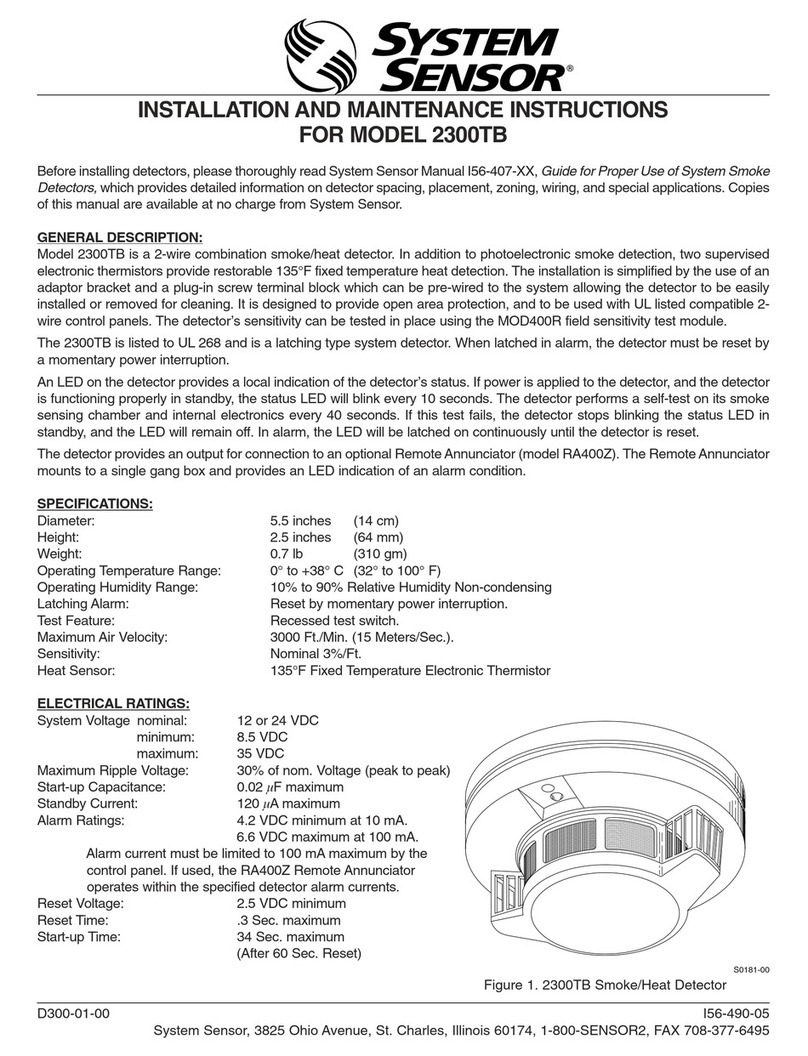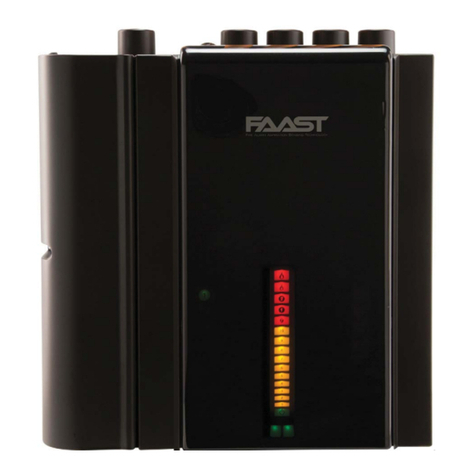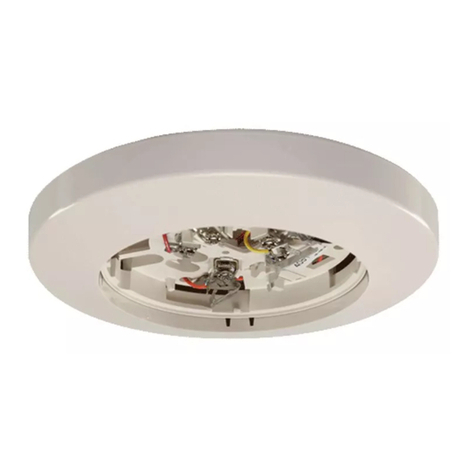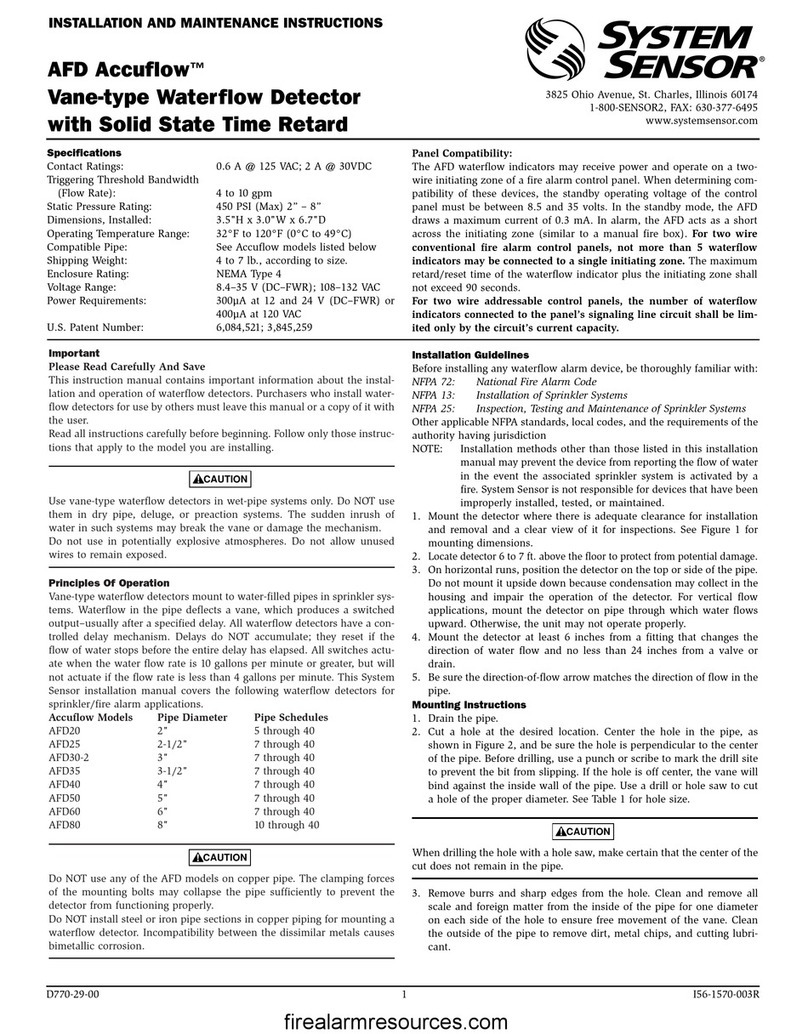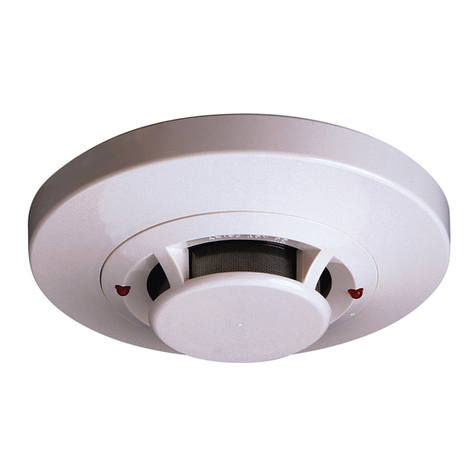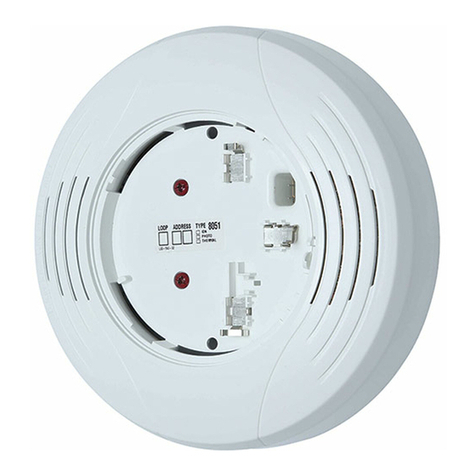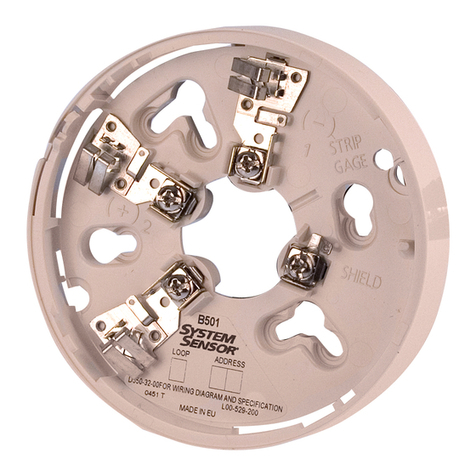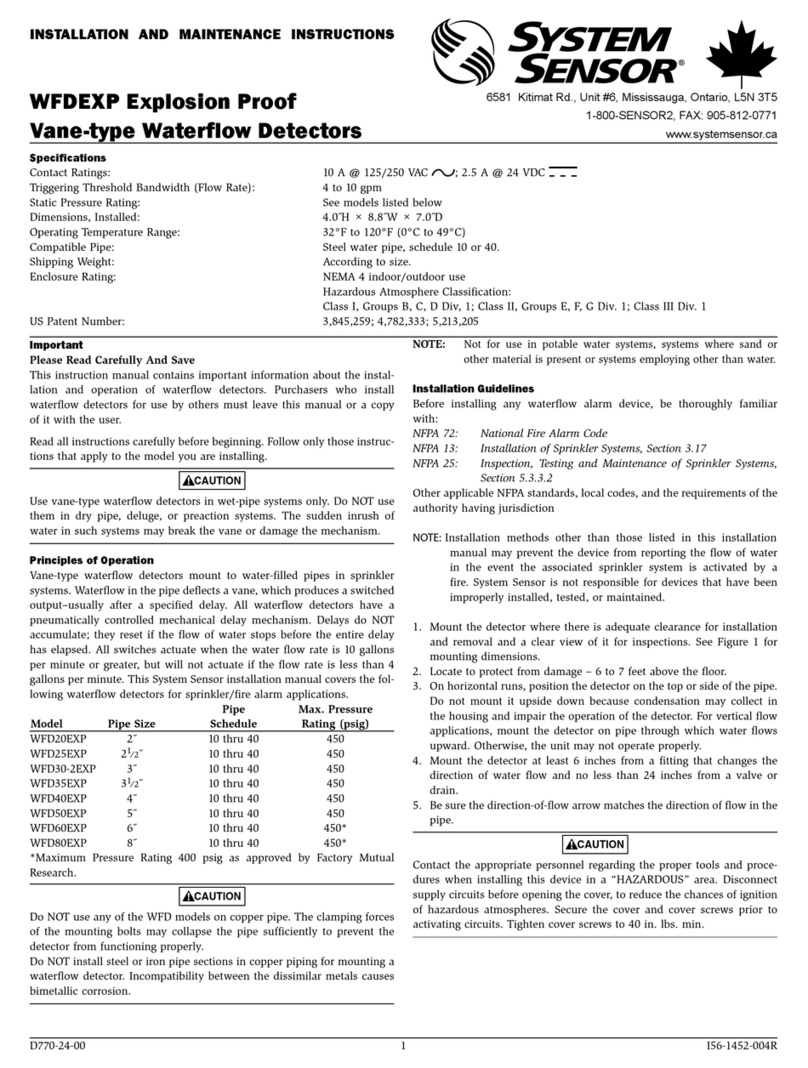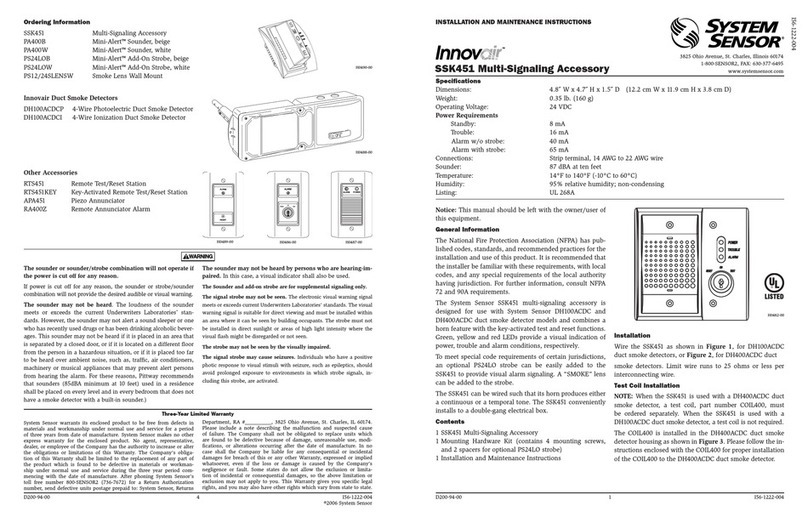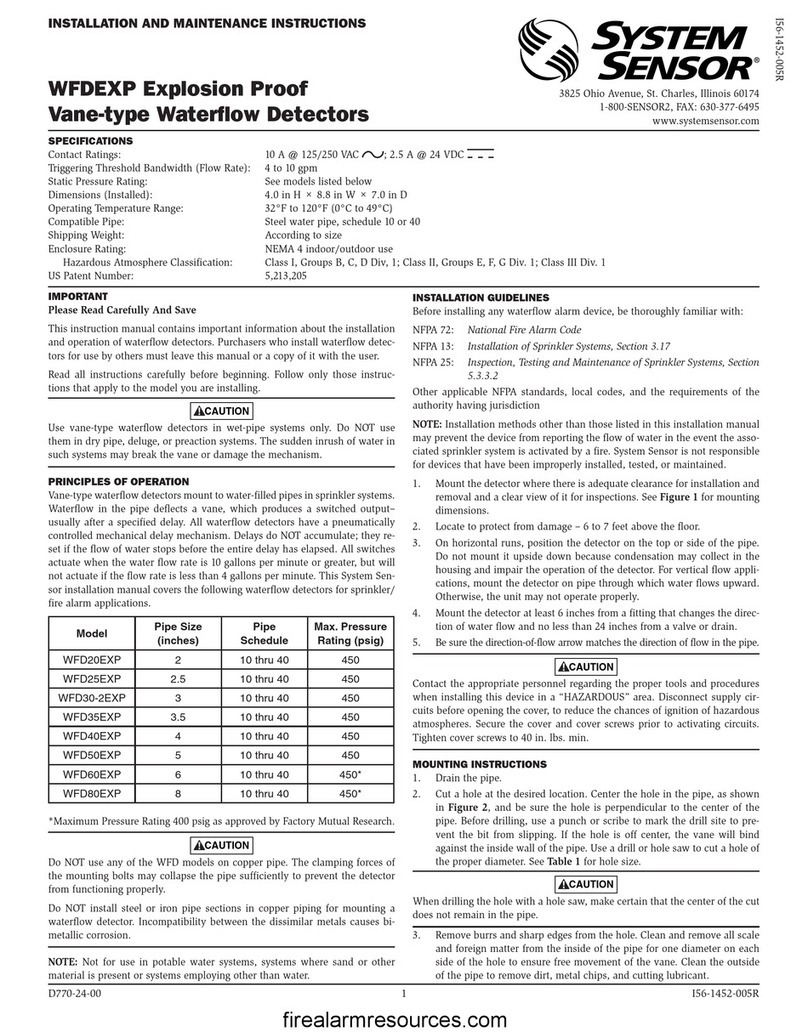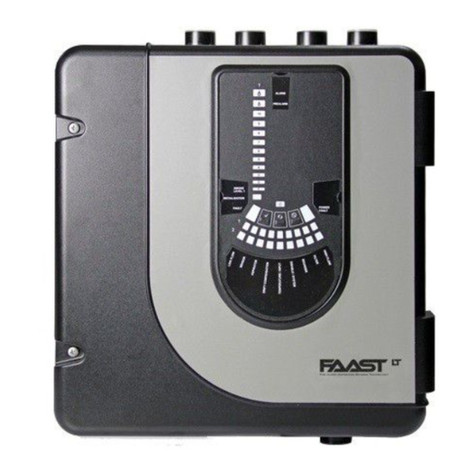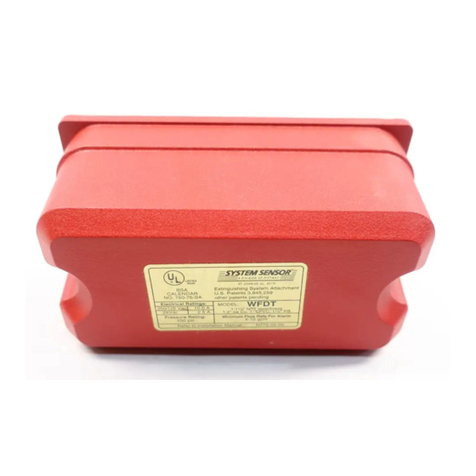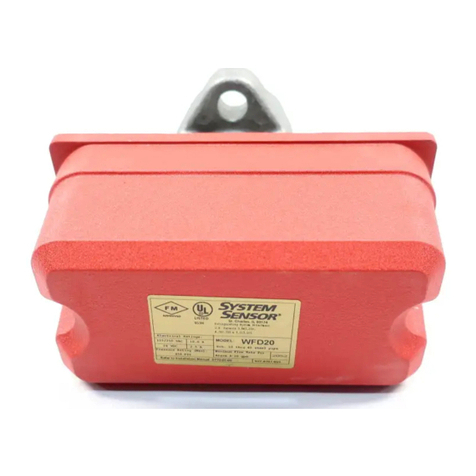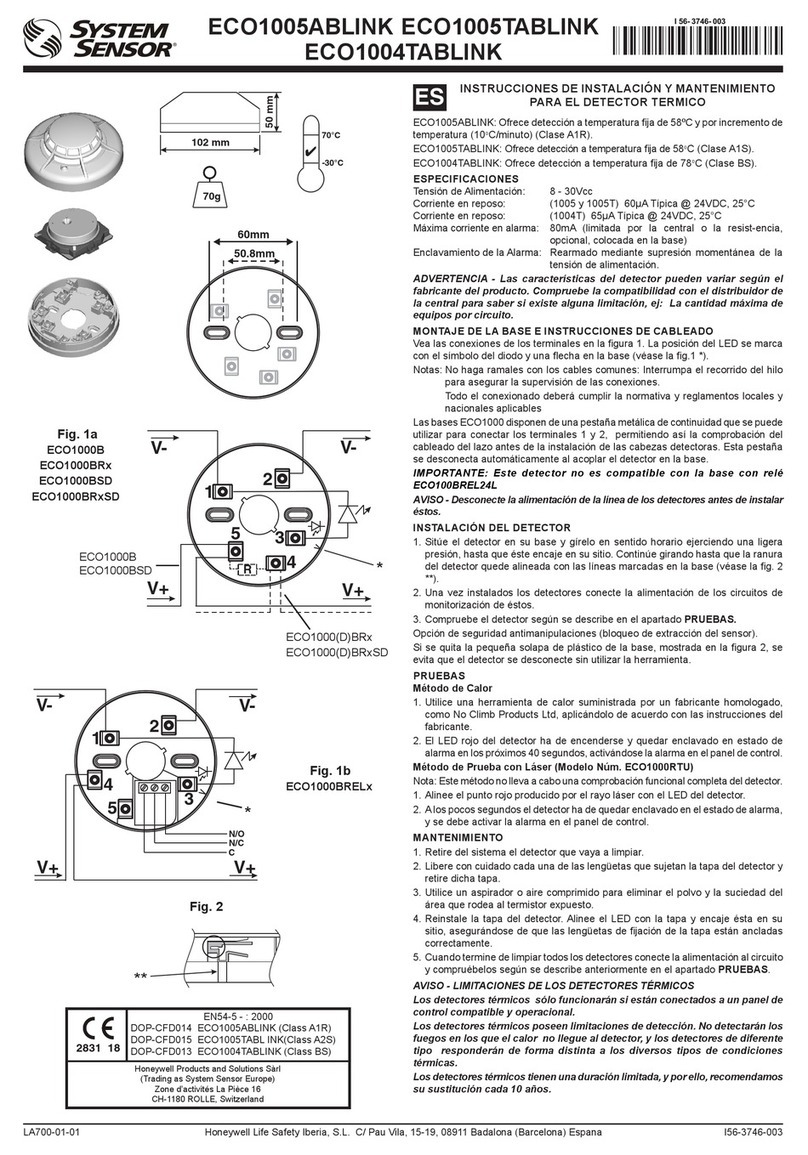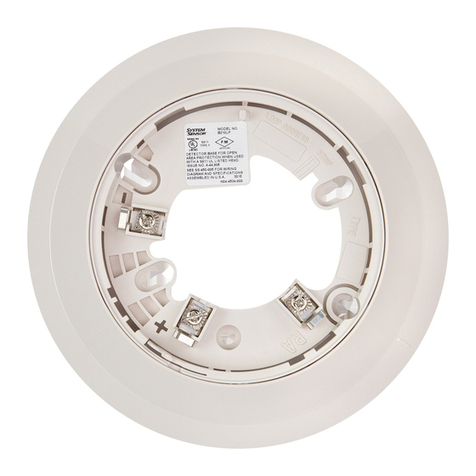D550-31-10 Pittway Tecnologica S.r.l., Via Caboto 19/3, 34147 Trieste, Italy © System Sensor 2008 I56-1642-014
2
0832
0832-CPD-0926
0832
0832-CPD-0926
ANLEITUNG FÜR DEN EINBAU VON KOMPAKTEN ISOLATOREN, MODELL ISO524-1
ALLGEMEINE BESCHREIBUNG
Lesen Sie bitte vor dem Einbau von Meldern sorgfältig die Handbücher für die Verdrahtung und den Einbau, und sehen Sie die in Frage kommenden
nationalen und lokalen Bestimmungen und Ausführungsvorschriften für die Planung und die Installation von Brandmeldesystemen durch.
Der Kurzschluß-Isolator ISO524-1 von System Sensor ist für den Einsatz bei allen Meldern und Modulen der Serien 200, 500 und 700 geeignet. Er
verhindert, daß ein kompletter Loop beim Auftreten eines Kurzschlusses ausfällt. Dies wird erreicht, indem der Teil des Loops, in dem der
Kurzschluß auftritt, vom Rest des Loops abgetrennt wird. Diese Isolatoren stellen darüber hinaus die Gesamtfunktion des Loops wieder her, wenn die
Ursache des Kurzschlusses beseitigt ist. Der Isolator ist so gestaltet, daß im Falle des Auftretens eines Kurzschlusses zwischen benachbarten
ISO524-1 und/oder B524IEFTx (wobei keinerlei weitere Produkte dazwischen geschaltet sind) die Funktion der Gesamtschleife bei diesem einzelnen
Kurzschluß in Abhängigkeit von der Betriebsweise der Brandmelderzentrale voll erhalten bleibt.
Nachsatz:
Sind zwischen den betroffenen Isolatoren weitere Elemente an den Loop angeschlossen, können diese nicht mit der Brandmelderzentrale
kommunizieren, solange der Kurzschluss besteht.
SPEZIFIKATIONEN
Länge: 90mmmax.
Breite: 35mmmax.
Höhe: 10mmmax.
Längeder losenAnschlußdrähte: 120mm
Querschnittder losenAnschlußdrähte(Litze): 0,75mm²
Betriebstemperaturbereich: –30°Cbis 70°C
Feuchtigkeitsbereichim Betrieb: 0%bis95% relativeFeuchte (nichtkondensierend)
Betriebsspannungsbereich: 15 bis28,5 VDC
Stromim Bereitschaftsmodus: 100µA bei24 VDC
8µAbei 6VDC
Trennstrom: 15mAbei 24VDC
Leitungsimpedanzpro Sockel: 0,2Ohm max. bei24VDC
WARNUNG VerwendenSie keineIsolationsprüfgeräte,wenn Isolatormodule angeschlossensind.
INSTRUCCIONES DE INSTALACIÓN DEL AISLADOR COMPACTO MODELO ISO524-1
DESCRIPCIÓN GENERAL
Antes de instalar los detectores, lea atentamente los manuales de instalación y cableado del sistema y repase las normas nacionales y locales relativas
a las prácticas de planificación e instalación de sistemas de alarma de incendios.
El aislador de cortocircuitos ISO524-1 de System Sensor ha sido diseñado para utilizarse con todas las series 200, 500 y 700 de detectores analógicos
direccionables y módulos. Éstos evitan la desactivación de todo el bucle de comunicaciones a causa de un cortocircuito. Esto se logra aislando la parte
del bucle que contiene el cortocircuito del resto del circuito. Los aisladores también restablecen la parte correspondiente del bucle una vez corregido el
cortocircuito. El aislador ha sido diseñado de tal manera que si se produce un cortocircuito entre dos aisladores ISO524-1 y/o B524IEFTx sin elementos
conectados entre ambos, el funcionamiento del resto del bucle permanecerá inalterado en caso de cortocircuito en bucle cerrado, dependiendo del
funcionamientodelpanel de control.
ESPECIFICACIONES
Longitud: 90mm máx.
Ancho: 35mm máx.
Alto: 10mm máx.
LongituddeCable de conexión: 120mm
SeccióndeCable de conexión: Multifilamento 0,75mm²
Margen de Temperatura de Funcionamiento: –30°C a 70°C
Margen de Humedad en Funcionamiento: 0% a 95% de Humedad Relativa (sin condensación)
TensióndeFuncionamiento: 15 a 28,5 Vcc
Corriente en Reposo: 100µA a24 Vcc
8µAa6 Vcc
Corriente en Aislamiento: 15mAa 24Vcc
Impedancia de la línea por aislador: 0,2 ohms. máx. a 24 Vcc
ATENCIÓN No utilice unidades de prueba de continuidad de alta tensión, tales como megóhmetros, con los aisladores conectados.
MONTAJE
El aislador ISO524-1, gracias a su reducido tamaño, se puede instalar en el interior de cajas de conexiones, debajo de las bases de los sensores, dentro
de las cajas de pulsadores, o bien dentro de las cajas de módulos SMB500.
NORMAS DE INSTALACIÓN
Todo el cableado ha de instalarse de acuerdo con todas las normativas locales aplicables, y requerimientos especiales que determinen las autoridades
locales con jurisdicción, respecto a la sección correcta de los conductores. Los hilos que se utilicen para conectar los dispositivos al panel de control y
a los equipos accesorios han de estar codificados con colores para reducir la probabilidad de errores en el cableado. Un conexionado incorrecto puede
impedirqueel sistema responda adecuadamenteen caso de incendio.
Para el cableado del bucle (el cableado entre detectores y dispositivos conectados al panel), se recomienda una sección no inferior de 0,5 mm2. En
cualquier caso, con el aislador se pueden utilizar secciones de cable de hasta 2,5 mm2, utilizando los conectores adecuados al cable. Se recomienda el
uso de cable apantallado o de par trenzado para el lazo de alimentación (+ y -) para minimizar los efectos de interferencias eléctricas. Si se utiliza cable
apantallado, la conexión de la malla (Independiente) y del bucle al aislador ha de ser continua utilizando regletas, conectores de presión o soldadura,
segúnproceda,con el fin deobtener una conexión fiable.
Los paneles de control de sistemas de alarma poseen especificaciones de resistencia máxima permisible en el bucle. Consulte las especificaciones del
panel de control relativas a la resistencia total máxima permisible del bucle antes de conectar los bucles de los dispositivos.
1. Utilice los conectores de cable adecuados y conecte los cables positivos del lazo de entrada y salida a los dos cables rojos ISO524-1
disponibles.
2. Conecte el cable amarillo al positivo ( + ) del equipo para mantener el positivo del equipo con independencia de la posición de cortocircuito. De
lo contrario, no lo conecte.
3. Conecte los cables negativos del lazo de entrada y salida al cable negro ISO524-1 y al negativo ( - ) del equipo.
4. Compruebe la totalidad del cableado del bucle antes de conectar la alimentación eléctrica. Esto incluye la comprobación de los conductores
respecto a la continuidad, la polaridad adecuada y las pruebas de derivación a tierra.
5. Una vez comprobado el cableado del bucle se puede aplicar tensión eléctrica al sistema y ejecutar las pruebas de funcionalidad.
EINBAU
Die Isolatoren ISO524-1 können an den unterschiedlichsten Stellen eingebaut werden, die sich dafür eignen, z.B. in Verbindungsdosen, hinter
Meldersockeln,inDruckknopfmeldergehäusen oder inModulboxenSMB500.
EINBAUANLEITUNG
Die Verkabelung muß in Übereinstimmung mit den jeweiligen lokalen Bestimmungen und gesetzlichen Vorschriften erfolgen; auf die Verwendung der
richtigen Drahtquerschnitte ist zu achten. Für die Leitungen, die zur Verbindung von Rauchmeldern mit der Brandmelderzentrale und den
Zubehöreinheiten verwendet werden, sollte zur Vermeidung von Verdrahtungsfehlern eine farbliche Codierung eingeführt werden. Bei einer
fehlerhaften Verdrahtung besteht die Gefahr, daß das System in Falle eines Brandes falsch reagiert.
Der Drahtquerschnitt der Signalleitungen (die Leitungen zur Verbindung der Melder untereinander) sollte möglichst nicht geringer als 0,5 mm² sein.
An das Isolatormodul können Drähte mit einem Querschnitt bis zu 2,5 mm² angeschlossen werden; verwenden Sie passende Kabelanschlußelemente.
Für die Stromversorgung ist die Verwendung einer verdrillten oder abgeschirmten (+ und -) Doppelleitung empfehlenswert, um die Auswirkungen von
elektrischen Störungen auf ein Mindestmaß zu begrenzen. Wenn ein abgeschirmtes Kabel verwendet wird, muß die Abschirmung zum und vom
Isolatormodul elektrisch durchgeschleift werden; stellen Sie die Verbindung durch Schraubelemente, durch Crimpen oder Löten her, je nachdem was
sich für einen sicheren Kontakt als die geeignetste Lösung erweist.
Für Brandmelderzentralen gelten maximal zulässige Schleifenwiderstände. Vor der Verkabelung der Melder sollten Sie daher die Spezifikationen der
Brandmelderzentraledurchsehen,um sich über den zulässigenGesamtschleifenwiderstandzu informieren.
1. Schliessen Sie die ein- und ausgehenden Plusleitungen der Schleife mit geeigneten Kabelanschlusselementen jeweils an einen roten Draht
desISO524-1an.
2. Schliessen Sie den gelb Draht an den +ve Anschluß des Elements in der Kommunikationsschleife an, um die Funktion des Elements
unabhängig von der Lage eines auftretenden Kurzschlusses aufrecht zu erhalten. Wird der gelb Draht nicht angeschlossen ( Abb. A ), kann je
nach Lage eines auftretenden Kurzschlusses die Kommunikation mit dem Element der Schleife verloren gehen .
3. Schliessen Sie die ein- und ausgehende Minusleitung der Schleife an den einzelnen schwarzen Draht des ISO524-1 und an den -ve Anschluß
desElementsin der Kommunikationsschleife an.
4. Überprüfen Sie noch einmal die Verdrahtung des gesamten Loops, bevor Sie die Spannungsversorgung anschließen. Dazu gehört auch die
Überprüfung auf elektrische Durchgängigkeit und richtige Polarität sowie einTest auf Erd- bzw. Masseschluss.
5. Nach Überprüfung der gesamten Verkabelung kann die Stromversorgung angeschlossen werden, und es können Funktionstests durchgeführt
werden.
Figura1. Aspecto Abbildung1. Aussehen
( + )
( - )
( - )
( + )
( - ) ( - )
( + )( + )
